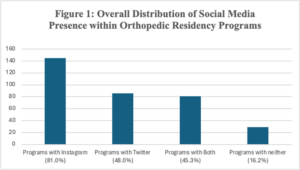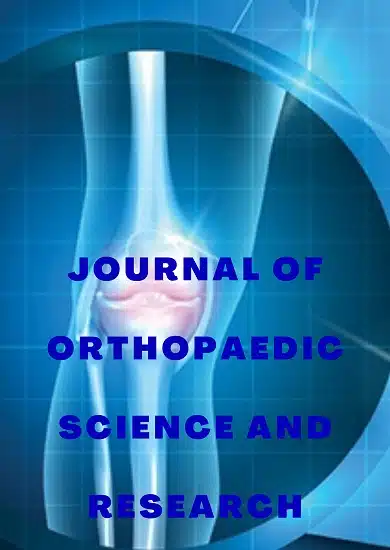Research Article | Vol. 6, Issue 1 | Journal of Orthopaedic Science and Research | Open Access |
Social Media Presence of Orthopedic Surgery Residency Programs Associates with Program Ranking But is No Longer Associated with Increased Applicant Diversity
Philip M Lee1*, Eli M Snyder1, Hyeong Jun Ahn2, Sudarsan Murali3, Dawn Laporte3, Amiethab Aiyer3
1University of Hawaii John A. Burns School of Medicine, Honolulu, HI, USA
2University of Hawaii, Department of Quantitative Health Sciences, Honolulu, HI, USA
3John Hopkins University Department of Orthopedics, Baltimore, Maryland, USA
*Correspondence author: Philip M Lee, BS, University of Hawaii John A. Burns School of Medicine, Honolulu, HI, USA;
Email: [email protected]
Citation: Lee PM, et al. Social Media Presence of Orthopedic Surgery Residency Programs Associates with Program Ranking But is No Longer Associated with Increased Applicant Diversity. J Ortho Sci Res. 2025;6(1):1-7.
Copyright© 2025 by Lee PM, et al. All rights reserved. This is an open access article distributed under the terms of the Creative Commons Attribution License, which permits unrestricted use, distribution, and reproduction in any medium, provided the original author and source are credited.
| Received 20 February, 2025 | Accepted 14 March, 2025 | Published 21 March, 2025 |
Abstract
Social media utilization by orthopedic surgery residency programs increased by 355% from the 2019 to 2021 residency application cycles. Prior to the COVID-19 pandemic, literature demonstrated an association between social media presence and diversity of residency programs. The goal of this study is to investigate the associations between social media presence, diversity and program rank following the dramatic increase in residency program social media use during the COVID-19 pandemic.
Social media platforms affiliated with all orthopedic surgery residency programs acknowledged by the Accreditation Council for Graduate Medical Education (ACGME) were identified via manual Google, Twitter and Instagram searches. Overall program rankings and research rankings were collected from the Doximity Navigator rankings list; a lower program rank denoted better-ranked programs (e.g., rank #1 represents the best program). Residency program demographics were collected through the Orthopedic Residency Information Network (ORIN) and binned into four quartiles to adjust for multivariable logistic regressions. Residency programs were categorized as “gender diverse” if either resident physicians were composed of ≥29.8% women, equivalent to one SD above the mean of 19.7% or if attending physicians were composed of ≥21.7% women, equivalent to one SD above the mean of 13.6%. Similarly, residency programs were categorized as “racially diverse” if either resident physicians were composed of ≥32.8% Underrepresented Minorities in Medicine (URiM), equivalent to one SD above the mean of 19.1% or if attending physicians were composed of ≥ 27.3% URiM, equivalent one SD above the mean of 13.8%. All data was collected during fall 2023. Confounding variables were controlled by regression analyses. Multivariable logistic regressions were used to further assess comparisons between presence of social media and program ranking, gender diversity and ethnic diversity.
A total of 179 orthopedic surgery residency programs accredited by the ACGME were included in the ORIN database. Of the 179 programs, 145 (81.0%) programs had Instagram, 86 (48.0%) had Twitter, 81 (45.3%) had both Instagram and Twitter accounts and 29 (16.2%) programs had neither. Pearson Correlation Coefficient tests demonstrated a negative linear relationship between total number of social media platforms per program and overall program rankings (R2= -0.53, p<0.01) as well as research program ranking (R2=-0.49, p<0.01). Spearman Correlation Coefficient tests confirmed overall program ranking (R2=-0.55, p<0.01) and research program ranking (R2=-0.51, p<0.001) as the dataset did not follow bell curve distribution. Chi-Square tests of independence did not demonstrate a significant relationship between presence of social media and gender diversity (x2=0.17, p=0.68) and Fisher’s exact tests confirmed no statistical significance (p=1.00). Chi-Square tests of independence also did not demonstrate a relationship between presence of social media and racial diversity (x2=0.25, p=0.62) and Fisher’s exact tests confirmed no statistical significance (p=0.64).
The COVID-19 pandemic greatly impacted social media use by orthopedic residency programs. Although prior literature demonstrated social media presence was associated with increased gender and racial applicant diversity, our findings show this association is no longer present. This may be due to the significant increase in social media use during the pandemic. Future research is encouraged to investigate alternative strategies to diversify orthopedic residency programs.
Keywords: Orthopedic Surgery; Diversity; Social Media; Medical Education; Surgical Education; Residency; Fellowship
Introduction
The American Association of Medical Colleges reports 87% of all board-certified orthopedic surgeons are male and 64% are Caucasian, making orthopedics the least diverse specialty in medicine [1,2]. Improved understanding of cultural humility has shown that diversity at medical institutions correlates with improved patient outcomes, team communication and financial performance [3,4]. Although social media has proven to be a valuable tool for tasks like marketing one’s practice, patient education and referral generation, social media has also been used by residency programs in efforts to improve diversity within orthopedic training programs [5-7]. This has shown to be an effective tool, as national surveys have demonstrated mentorship representation as one of the strongest factors in applicant selection for residency and fellowship training programs [8-10].
Many medical fields, such as anesthesia, dermatology, otolaryngology, orthopedic surgery and plastic surgery have utilized social media as a tool to improve workplace diversity [5,11-14]. Within orthopedic surgery specifically, social media presence of orthopedic residency programs has been associated with an increase in residency program applications, as well as an increase in racial and gender diversity of applicants [15,16]. Many residency programs have found social media as an effective tool to demonstrate diversity at their institutions. However, since the start of the COVID-19 pandemic, social media utilization by orthopedic surgery residency programs increased by 355% [17].
The goal of this study is to investigate the association between social media presence with program diversity as well as national program rankings. The dramatic increase in orthopedic residency program social media use since the pandemic may have affected existing associations. This analysis offers insights for residency programs to consider as they develop strategies to create a more diverse training environment.
Methods
Study Design and Data Characteristics
Social media platforms affiliated with all orthopedic surgery residency programs acknowledged by the Accreditation Council for Graduate Medical Education (ACGME) were identified via manual Google, Twitter and Instagram searches. Profiles were identified by searching for links on each program’s main website as well as searching program’s name on Twitter and Instagram. This methodology has been utilized and validated by prior studies [14,15]. Twitter and Instagram were chosen because prior literature has shown these specific social media platforms play a large role in surgical residency programs marketing their institutions [14,18-22]. Only one social media account on each platform was included for each program.
Overall program rankings and research rankings were collected from the Doximity Residency Navigator, an online platform that quantifies residency program metrics based on more than 54,000 board-certified physician reviews [23]. The Doximity Residency Navigator has been validated by prior studies in evaluating surgical training programs in the United States [13,14]. Lower program rank denoted better-ranked programs (e.g., rank #1 represented the best program).
Residency program demographics were collected through the Orthopedic Residency Information Network (ORIN), a database of ACGME accredited orthopedic surgery residency programs across the US. Data included distributions of gender and ethnicity for resident and attending physicians.
Statistical Analysis
Residency program demographics collected through the ORIN were binned into four quartiles to adjust for multivariable logistic regressions. This adjustment method has been utilized in previous studies investigating social media in residency programs14.
Residency programs were categorized as “gender diverse” if either resident physicians were composed of ≥29.8% women, equivalent to one SD above the mean of 19.7% or if attending physicians were composed of ≥21.7% women, equivalent to one SD above the mean of 13.6%. Similarly, residency programs were categorized as “racially diverse” if either resident physicians were composed of ≥32.8% Underrepresented Minorities in Medicine (URiM), equivalent to one SD above the mean of 19.1% or if attending physicians were composed of ≥ 27.3% URiM, equivalent one SD above the mean of 13.8%.
All data was collected during fall 2023. Confounding variables were controlled by regression analyses. Multivariable logistic regressions were used to further assess comparisons between presence of social media and program ranking, gender diversity and ethnic diversity. Significance for multivariable logistic regression was set at p<.01. All statistical analyses were per- formed using STATA Statistical Software, Release 16 (StataCorp LLC, 2019).
Results
Overall Results
A total of 179 orthopedic surgery residency programs accredited by the ACGME were included in the ORIN database. Of the 179 programs, 145 (81.0%) programs had Instagram, 86 (48.0%) had Twitter, 81 (45.3%) had both Instagram and Twitter accounts. 29 (16.2%) programs had neither. 19.1% of residents and 13.8% of attendings were considered URiM, while 19.7% of residents and 13.6% of attendings were female. Fig. 1 represents the distribution of orthopedic residency program social media presence.

Figure 1: Overall distribution of social media presence among orthopedic surgery residency programs.
Program Diversity and Overall Program Rankings
Pairwise Pearson Correlation Coefficients demonstrated a better overall program ranking was associated with a greater percentage of female residents (R2=-0.41, p<0.01), female attending physicians (R2=-0.24, p<0.01) and URiM attending physicians (R2=0.29, p<0.01). As the data did not follow a normal Bell curve distribution, Spearman Correlation Coefficients further confirmed this association between better program ranking and increased gender and racial diversity, with female residents (R2=-0.45, p<0.01), female attending physicians (R2=-0.26, p<0.01) and URiM attending physicians (R2=0.29, p<0.01).
Similarly, Correlation Coefficients demonstrated a relationship between research program ranking and percentage of female residents (R2=-0.36, p<0.01) as well as female attending physicians (R2=-0.36, p<0.01). As the data did not follow a normal Bell curve distribution, Spearman Correlation Coefficients confirmed this increase in percentage of female residents (R2=-0.38, p<0.01) and female attending physicians (R2=-0.34, p<0.01).
Social Media Presence and Overall Program Rankings
Two-sample t-tests were performed to evaluate the relationship between presence of any social media account and program ranking. Of programs without any social media, the mean reputation ranking was 155.5, whereas programs with any social media had a mean Doximity reputation ranking of 83.0 (p<0.01). Non-parametric t-tests were also performed as the Doximity rankings did not follow a normal Bell curve distribution; results were consistent and showed statistical significance (p<0.01). Similar analyses were performed evaluating social media and mean research rank. Of programs without social media, the mean research ranking was 150.4, whereas programs with any social media had a mean research reputation of 84.7 (p<0.01).
Pearson Correlation Coefficient tests demonstrated a negative linear relationship between total number of social media platforms per program and overall program rankings (R2= -0.53, p<0.01) as well as research program ranking (R2=-0.49, p<0.01). Spearman Correlation Coefficient tests confirmed overall program ranking (R2=-0.55, p<0.01) and research program ranking (R2=-0.51, p<0.01).
Social Media Presence and Program Diversity
Chi-Square tests of independence did not demonstrate a significant relationship between presence of social media and gender diversity (x2=0.17, p=0.68) and Fisher’s exact tests confirmed no statistical significance (p=1.00). Chi-Square tests of independence also did not demonstrate a relationship between presence of social media and racial diversity (x2=0.25, p=0.62) and Fisher’s exact tests confirmed no statistical significance (p=0.64). Table 1 demonstrates the relationship between social media presence and gender and racial diversity.
| Gender Div. | Gender Div. | Racial Div. | Racial Div. |
Type of Social Media | X2 | p | X2 | p |
Any Social Media | 0.17 | 0.68 | 0.25 | 0.62 |
0.20 | 0.71 | 0.27 | 0.63 | |
0.15 | 0.62 | 0.22 | 0.61 |
Table 1: Relationship between social media presence and gender / racial diversity.
Discussion
Within the past decade, there has been an increase of social media use for tasks such as medical practice marketing, patient education and referral generation [5-7]. Within a medical education perspective, social media is being used with a goal of attracting diverse residency program applicants [15,16]. This current study demonstrated that 83.8% of institutions had at least one form of social media including Instagram and Twitter. Although this study demonstrates a relationship between social media presence and better overall program rankings, there is no longer an association between social media presence and residency program diversity when compared to studies prior to the COVID-19 pandemic [17].
Diversity within Orthopedic Surgery
All medical specialties have directed effort towards diversifying their fields. Literature has demonstrated advantages to diverse physician populations, not only in improved quality of patient care and communication, but also maximization of revenue generation [3,4]. In the early 2000’s, the percentage of female orthopedic surgery residents rose at the slowest rate compared to all medical specialties in the United States, while the percentage of URiM residents trended downwards [24]. In 2017, orthopedic surgery continued to have the lowest percentage of female residents at 14.0%, as well as the lowest percentage of African American and Hispanic residents at 4.1% and 2.7% of orthopedic trainees respectively [24,25]. Diversity should be increased in order to effectively care for patients of all cultural, ethnic and socioeconomic backgrounds [9].
Prior literature has focused on identifying factors contributing to the lack of diversity in the field of orthopedic surgery. One component was the pool of applicants to orthopedic surgery residency programs, which was predominated by males of Caucasian and Asian descent [24]. This is further supported by another study which demonstrated the proportions in which female and URiM applicants applied to versus matched into orthopedic surgery residency programs were consistent with the overall application – match ratio [26]. In other words, the lack of diversity in orthopedic surgery was from a lack of diverse applicants. This prompted strategies in improving diversity by attracting a more diverse applicant pool, such as female and URiM applicants.
Social Media’s Role in Improving Diversity of Residency Programs
Within the past two decades, social media has incorporated itself as a cornerstone of medicine, both in practice and in medical education. Novel examples of social media’s utility include medical researchers sharing new literature with other scientists, as well as physicians educating their followers and promoting their practice [6,7,27,28]. Within medical education, medical schools and residency programs have utilized social media to promote their institutions and national surveys of surgical residency directors have even reported that applicants’ social media greatly assists in their selection process [5,14,29,30].
Social media’s growing role in the field of medicine was only augmented by the COVID-19 pandemic. Between the 2019 to 2021 application cycles, orthopedic residency programs reported a 355% increase in social media utilization for institutional promotion [17]. During national surveys, a majority of institutions reported social media to be “extremely important” or “very important” when compared with utility from previous year [17]. Additionally, orthopedic residency program directors reported one of the biggest changes in selection criteria included virtual information session attendance, describing virtual rotations attendance as “extremely” or “very important” [31].
As in-person events shut down, orthopedic residency programs depended more on virtual platforms, with 83.8% of residency programs now utilizing social media compared to 39.7% in 2021 [17]. The combination of increased utilization and increased importance of social media and online platforms during the COVID-19 pandemic may have created a ‘diluting’ effect. Although social media may be used to attract a diverse applicant pool, the dramatic increase in orthopedic residency program social media use during the pandemic may have affected existing associations [8-10]. Future research should focus on developing alternative strategies to create a more diverse training environment.
Limitations
This study has several limitations. First, the retrospective nature of this study limits the findings to correlation rather than causation. Furthermore, this study was limited to the accuracy and completeness of the ORIN dataset which relies on self-reported data from orthopedic residency programs. As each program is responsible for updating their respective data, some programs may have included more up to date information than others; however, data was provided no earlier than 2021. Additionally, the ORIN dataset only included 179 of the 203 accredited programs and did not have complete demographic information for every program, subsequently being excluded during statistical analysis. This may have affected distribution of results. Despite these limitations, the ORIN database provided data directly from program administrators, useful to explore the association between social media presence and diversity of orthopedic surgery residency programs. Another potential limitation to this study is utilizing the Doximity database, as other ranking systems such as BlueRidge and USNWR may rank institutions differently. However, prior research has shown Doximity rankings are associated with academic performance and productivity [32-37].
Conclusion
Social media has become a cornerstone of both medical education and practice. Prior literature demonstrated social media may be an effective tool for diversifying residency programs, especially within the field of orthopedic surgery. This study demonstrates that although social media presence does correlate with overall program rankings, there is no longer an association between social media presence of orthopedic surgery residency programs and increased program diversity, following the significant increase in social media utilization during the COVID-19 pandemic. Future research is recommended to investigate additional strategies to effectively increase program diversity.
Conflict of Interests
The authors declare that they have no conflict of interest in this paper.
Funding/Sponsorship
Not applicable
References
- 2023-2024 Residency Navigator is Now Live! [Last accessed on: March 14, 2025].
https://blog.doximity.com/articles/2023-2024-residency-navigator-is-now-live
- Economides JM, Choi YK, Fan KL, Kanuri AP, Song DH. Are we witnessing a paradigm shift?: A systematic review of social media in residency. Plast Reconstr Surg Glob Open. 2019;7(8):e2288.
- Langenfeld SJ, Vargo DJ, Schenarts PJ. Balancing privacy and professionalism: A survey of general surgery program directors on social media and surgical education. J Surg Educ. 2016;73(6):e28-e32.
- Meyer AM, Hart AA, Keith JN. COVID-19 increased residency applications and how virtual interviews impacted applicants. Cureus. 2022;14(6):e26096.
- Poon S, Kiridly D, Mutawakkil M. Current trends in sex, race and ethnic diversity in orthopaedic surgery residency. J Am Acad Orthop Surg. 2019;27(16):e725-33.
- Day CS, Lage DE, Ahn CS. Diversity based on race, ethnicity and sex between academic orthopaedic surgery and other specialties: A comparative study. J Bone Joint Surg Am. 2010;92(13):2328-35.
- Bradley EH. Diversity, inclusive leadership and health outcomes. Int J Health Policy Manag. 2020;9(7):266-8.
- Meade PJ, Amin SJ, Stamm MA, Mulcahey MK. Doximity orthopaedic surgery program rankings are associated with academic productivity. JB JS Open Access. 2023;8(1):e22.00081.
- Levy KH, Gupta A, Murdock CJ. Effect of faculty diversity on minority student populations matching into orthopaedic surgery residency programs. JB JS Open Access. 2023;8(1):e22.00117.
- Wang KY, Babu J, Zhang B, Jami M, Musharbash F, LaPorte D. Effect of the COVID-19 pandemic on the orthopaedic surgery residency application process: What can we learn? J Am Acad Orthop Surg Glob Res Rev. 2021;5(10):e21.00204.
- ERAS® Statistics. AAMC. [Last accessed on: March 14, 2025].
https://www.aamc.org/data-reports/data/eras-statistics-data
- Poon S, Kiridly D, Brown L. Evaluation of sex, ethnic and racial diversity across US ACGME-accredited orthopedic subspecialty fellowship programs. Orthopedics. 2018;41(5):282-8.
- Xie DX, Dedmon MM, O’Connell BP, Yawn RJ, Haynes DS. Evaluation of social media presence of otolaryngology residency programs in the United States. JAMA Otolaryngol Head Neck Surg. 2018;144(9):802-6.
- Butler BA, Johnson D, Christian RA, Bigach SD, Beal MD, Peabody TD. Factors influencing subspecialty choice of orthopedic residents: effect of gender, year in residency and presumptive subspecialty. Iowa Orthop J. 2020;40(1):19-23.
- Rao RD, Khatib ON, Agarwal A. Factors motivating medical students in selecting a career specialty: relevance for a robust orthopaedic pipeline. J Am Acad Orthop Surg. 2017;25(7):527-35.
- Alomar AZ. Fellowship and future career plans for orthopedic trainees: Gender-based differences in influencing factors. Heliyon. 2022;8(9).
- Haeberle HS, Bartschat NI, Navarro SM. Hip arthroscopy: A social media analysis of patient perception. Orthop J Sports Med. 2019;7(6):2325967119854188.
- Butler M, McCreedy E, Schwer N. Improving Cultural competence to reduce health disparities. Agency for healthcare research and quality (US); 2016. [Last accessed on: March 14, 2025].
http://www.ncbi.nlm.nih.gov/books/NBK361126/
- Bickel J, Wara D, Atkinson BF, et al. Increasing women’s leadership in academic medicine: Report of the AAMC Project Implementation Committee. Acad Med. 2002;77(10):1043-61.
- Sáenz JA, Gala DH de la, Bui PPB. Instagram’s influence on radiology today: reviewing the evolving educational journey from a hospital to national societies. Journal of Digital Imaging. 2021;34(5):1316.
- Ahmadmehrabi S, Xie DX, Ward BK, Bryson PC, Byrne P. OHNS residency program and applicant social media presence during the COVID-19 pandemic. Ann Otol Rhinol Laryngol. 2021;130(8):961-5.
- Okike K, Phillips DP, Johnson WA, O’Connor MI. Orthopaedic faculty and resident racial/ethnic diversity is associated with the orthopaedic application rate among underrepresented minority medical students. J Am Acad Orthop Surg. 2020;28(6):241-7.
- Khalafallah YM, Markowitz M, Levine WN, LaPorte DM, Aiyer AA. Orthopaedic surgery residency application and selection criteria adaptations, in times of COVID-19: A survey study. JB JS Open Access. 2022;7(2):e21.00145.
- Heard JR, Wyant WA, Loeb S, Marcovich R, Dubin JM. Perspectives of residency applicants and program directors on the role of social media in the 2021 urology residency match. Urology. 2022;164:68-73.
- Ramirez RN, Franklin CC. Racial diversity in orthopedic surgery. Orthop Clin North Am. 2019;50(3):337-44.
- Am A, Aa H, Dx X, Mk L. Recommendations for the rising otolaryngology residency programs’ social media presence. The Laryngoscope. 2021;131(6).
- Ames SE, Parker CJ. SES042 Specialty Update: Orthopaedic Surgery. 2023.
- Wang KY, Puvanesarajah V, Suresh KV. Social media presence is associated with diversity and application volume for orthopedic surgery residency programs. Orthopedics. 2023;46(1):47-53.
- Jildeh TR, Okoroha KR, Guthrie ST, Parsons TW. Social media use for orthopaedic surgeons. JBJS Rev. 2019;7(3):e7.
- Gary JL. Social media: How to use it effectively. J Orthop Trauma. 2015;29 Suppl 11:S5-8.
- Langdell HC, Levites HA, Lebhar MS, Wickenheisser VA, Phillips BT. Social media: Is it worth the hype for plastic surgery residency program recruitment? J Plast Reconstr Aesthet Surg. 2021;74(9):2392-42.
- Pershad Y, Hangge PT, Albadawi H, Oklu R. Social medicine: Twitter in healthcare. J Clin Med. 2018;7(6):121.
- Dunn LK, Pham E, Kabil E, Kleiman AM, Hilton EJ, Lyons GR, et al. The impact of physician race and sex on patient ranking of physician competence and perception of leadership ability. Cureus. 2023;15(2):e34778.
- Renew JR, Ladlie B, Gorlin A, Long T. The impact of social media on anesthesia resident recruitment. J Educ Perioper Med. 2019;21(1):E632.
- Irwin TJ, Riesel JN, Ortiz R, Helliwell LA, Lin SJ, Eberlin KR. The impact of social media on plastic surgery residency applicants. Ann Plast Surg. 2021;86(3):335-9.
- Shah A, Champagne AA, Del Papa J, Toor J, Larouche J, Nousiainen MT. The unique impact of COVID-19 on orthopedic surgery residency applicants and program directors in Canada. Can J Surg. 2021;64(2):E249-52.
- Choo EK, Ranney ML, Chan TM. Twitter as a tool for communication and knowledge exchange in academic medicine: A guide for skeptics and novices. Med Teach. 2015;37(5):411-6.
Author Info
Philip M Lee1*, Eli M Snyder1, Hyeong Jun Ahn2, Sudarsan Murali3, Dawn Laporte3, Amiethab Aiyer3
1University of Hawaii John A. Burns School of Medicine, Honolulu, HI, USA
2University of Hawaii, Department of Quantitative Health Sciences, Honolulu, HI, USA
3John Hopkins University Department of Orthopedics, Baltimore, Maryland, USA
*Correspondence author: Philip M Lee, BS, University of Hawaii John A. Burns School of Medicine, Honolulu, HI, USA;
Email: [email protected]
Copyright
Philip M Lee1*, Eli M Snyder1, Hyeong Jun Ahn2, Sudarsan Murali3, Dawn Laporte3, Amiethab Aiyer3
1University of Hawaii John A. Burns School of Medicine, Honolulu, HI, USA
2University of Hawaii, Department of Quantitative Health Sciences, Honolulu, HI, USA
3John Hopkins University Department of Orthopedics, Baltimore, Maryland, USA
*Correspondence author: Philip M Lee, BS, University of Hawaii John A. Burns School of Medicine, Honolulu, HI, USA;
Email: [email protected]
Copyright© 2025 by Lee PM, et al. All rights reserved. This is an open access article distributed under the terms of the Creative Commons Attribution License, which permits unrestricted use, distribution, and reproduction in any medium, provided the original author and source are credited.
Citation
Citation: Lee PM, et al. Social Media Presence of Orthopedic Surgery Residency Programs Associates with Program Ranking But is No Longer Associated with Increased Applicant Diversity. J Ortho Sci Res. 2025;6(1):1-7.



